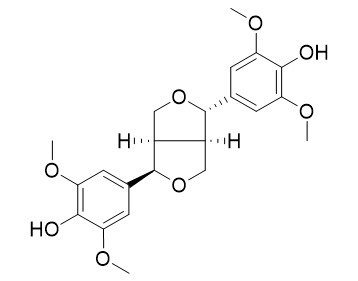Episyringaresinol
Episyringaresinol is a natural product from Kalimeris indica.
Inquire / Order:
manager@chemfaces.com
Technical Inquiries:
service@chemfaces.com
Tel:
+86-27-84237783
Fax:
+86-27-84254680
Address:
1 Building, No. 83, CheCheng Rd., Wuhan Economic and Technological Development Zone, Wuhan, Hubei 430056, PRC
Providing storage is as stated on the product vial and the vial is kept tightly sealed, the product can be stored for up to
24 months(2-8C).
Wherever possible, you should prepare and use solutions on the same day. However, if you need to make up stock solutions in advance, we recommend that you store the solution as aliquots in tightly sealed vials at -20C. Generally, these will be useable for up to two weeks. Before use, and prior to opening the vial we recommend that you allow your product to equilibrate to room temperature for at least 1 hour.
Need more advice on solubility, usage and handling? Please email to: service@chemfaces.com
The packaging of the product may have turned upside down during transportation, resulting in the natural compounds adhering to the neck or cap of the vial. take the vial out of its packaging and gently shake to let the compounds fall to the bottom of the vial. for liquid products, centrifuge at 200-500 RPM to gather the liquid at the bottom of the vial. try to avoid loss or contamination during handling.
Nutr Res Pract2019, 13:e45
Viruses.2017, 9(10)
Microb Pathog.2019, 131:128-134
Chinese Journal of Hospital Pharmacy2020, 40(7)
Biotechnology and Bioprocess Engineering2024, 29:1048-1060.
Plant Commun.2024, 5(10):101005.
Research Square2021, 10.21203.
Food Res Int.2024, 197(Pt 1):115244.
Phys Chem Chem Phys.2018, 20(23):15986-15994
J Chromatogr B Analyt Technol Biomed Life Sci.2021, 1187:123012.
Related and Featured Products
Chem Pharm Bull (Tokyo). 2012;60(9):1125-33.
Lignans and triterpenes from the root of Pseuderanthemum carruthersii var. atropurpureum.[Pubmed:
22976320]
METHODS AND RESULTS:
Two new lignans, pseuderesinol (1), pseuderanoside (2) and a new triterpene, pseuderanic acid (3) were isolated from the dried root of Pseuderanthemum carruthersii (SEEM.) GUILL. var. atropurpureum (BULL.) FOSB. (Acanthaceae), together with ten known compounds, including five lignans, (+)-eudesmin (4), (+)-magnolin (5), (+)-syringaresinol (6), (+)-Episyringaresinol (7), (+)-1-hydroxysyringaresinol (8) and five triterpenes, squalene (9), oleanolic acid (10), lupeol (11), betulin (12), betulinic acid (13). Their chemical structures were elucidated by 1D- and 2D-NMR, computational quantum chemistry, as well as high resolution-electrospray ionization (HR-ESI)-MS spectroscopic analysis.
The acetylcholinesterase inhibition and cytotoxic activities against HeLa and MCF-7 cancer cell lines were evaluated on some purified compounds at the concentration of 100 µg/mL.
CONCLUSIONS:
Pseuderesinol (1) and magnolin (5) exhibited moderate cytotoxic activities against the MCF-7 cancer cell line.
Nat Prod Res. 2017 Oct;31(20):2348-2353.
Two new terpenoids from Kalimeris indica.[Pubmed:
28326842 ]
METHODS AND RESULTS:
A new nor-sesquiterpene kalimeristone A (1), a new nor-triterpenoid kalimerislactone B (2) and eight known compounds 7-hydroxy-4'methoxyisoflavone (3), Episyringaresinol (4), epipinoresinol (5), rhamnetin (6), vanillin (7), p-hydroxybenzaldehyde (8), syringic acid (9) and 3, 4-dihydroxybenzaldehyde (10) were isolated from the herbs of Kalimeris indica. The structures of these compounds were elucidated using spectroscopic techniques, such as NMR and MS.
CONCLUSIONS:
All of the compounds were isolated from this genus for the first time. The cytotoxicities against four cancer cell lines were evaluated in vitro, but were inactive.



